Before You Start
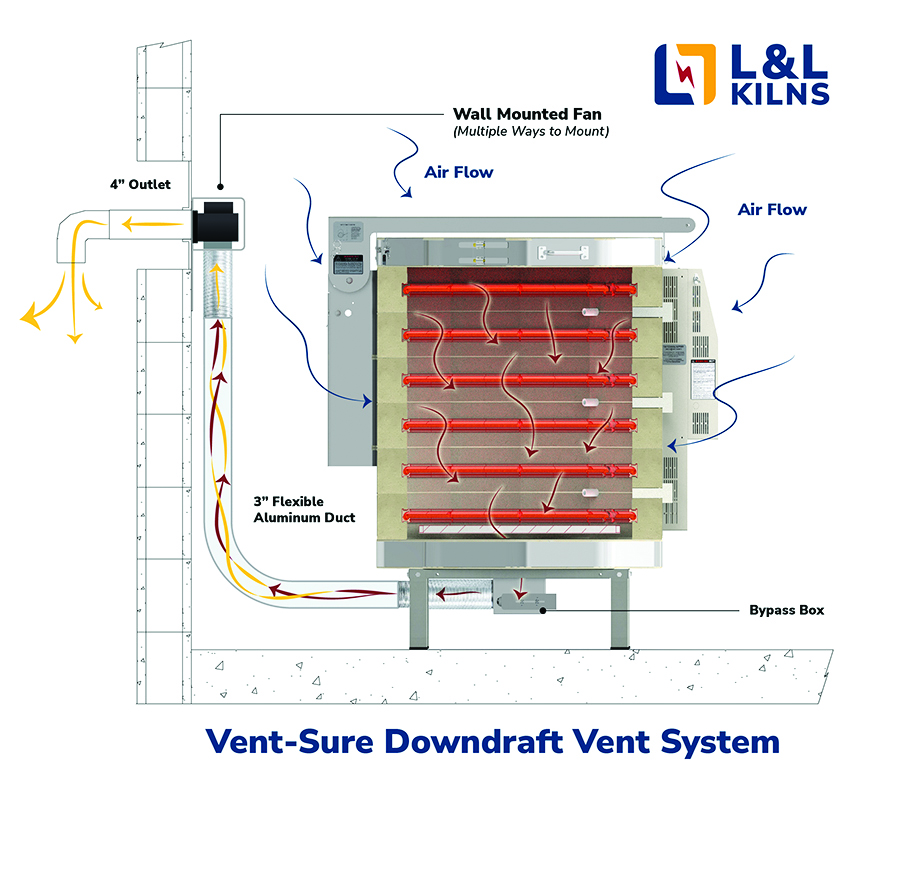
CHECKING SHIPMENT
Your ventilation system was carefully packed and inspected before shipment. When you receive the delivery, immediately unpack the ventilation system and accessories. Check for any damage that may have occurred during transit. If you find damage, keep all packaging materials and notify L&L immediately. Keep all paperwork to ensure a proper claim can be filed.
WHAT IS INCLUDED WITH VENT
- One (1) wall-mounted blower mounted on a bracket with vent pipe to go through outside wall and a Motor Inlet Duct.
- An 8 foot power cord with an attached On/Off switch plugs into a 120 volt standard receptacle. (Note: 220-240 volt models will have a different cord).
- One (1) Bypass Collection Box to be mounted to the kiln stand, with mounting hardware.
- One (1) length of flexible aluminum ducting (expands to 8 feet) with two (2) hose clamps.
- One (1) 4” diameter 90 degree elbow (for outside the building).
- One (1) Multi-Mount Bracket
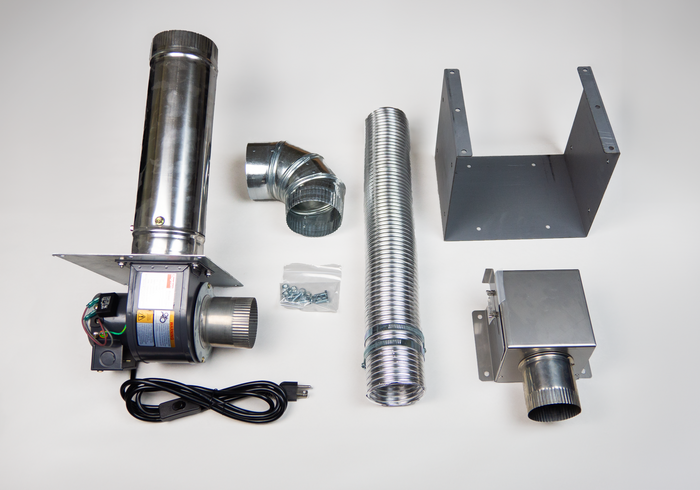
INSTALLATION TIP BEFORE STARTING
Attach the Bypass Box to the stand and the aluminum duct to the Bypass Box before installing the kiln on the stand because it can be hard to do this when the kiln is on top of the stand.
INTRODUCTION
WHAT DOES THE VENT DO?
The Vent-Sure Kiln Ventilation System is designed to pull air contaminated with carbon monoxide and other fumes including those of volatile metals, decals, sulfur oxide, and others in a down draft fashion out of the kiln and then vent it outside or to a central vent system.
KILN VENTILATION CAUTIONS
Duct and Vent Safety
- Check the duct occasionally for wax or other buildup. Wax can condense in the duct, which is a fire hazard. This is important if you use a wax resist.
- Ensure the vent exhaust does not re-enter the building. Keep the vent exit at least four feet from open windows or doors.
- Use a carbon monoxide monitor in the kiln room. These are inexpensive and available at hardware stores.
- Disconnect the power cord before maintaining the fan motor. Do not put fingers inside the blower without disconnecting power. The blower may start unexpectedly due to the thermal shut-off switch. Do not place anything in the blower/motor while powered. This could cause injury or motor damage.
VENTILATION IS ESSENTIAL
Kiln Fume Safety
- Kilns produce harmful fumes when firing ceramics, including carbon monoxide, sulfur oxides, hydrogen fluoride, and metal vapors. These fumes can be toxic.
- Install the kiln in a well-ventilated area. Do not operate in an enclosed space without good airflow.
- Kiln fumes, salt air, or other environmental conditions can cause severe corrosion.
Kiln Ambient Heat and Ventilation
- The kiln should operate in an environment that is between -18°C (0°F ) and 38°C (100°F).
- Kiln vents do not take care of ambient ventilation of the kiln room to remove the heat of the kiln.
- See the following web page for guidance on how to calculate ventilation requirements for a kiln room: hotkilns.com/calculate-kiln-room-ventilation
Installing Vent
See https://www.youtube.com/video/EJCxVydGP4w?si=V8NgZSpcg3Ip7gOt
INSTALLATION
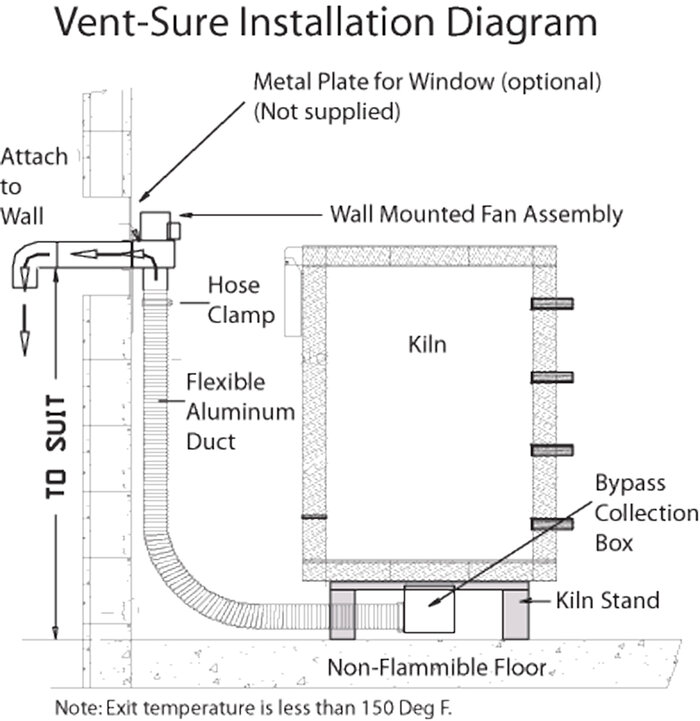
Important Cautions for Kiln Installation and Operation
- Ensure the kiln power is off before starting installation.
- Keep the vent outlet at least four feet away from open windows or doors to prevent fumes from re-entering the building, as these fumes can harm plants nearby.
Caution About Vertical Mounting
- If mounting the discharge duct vertically, use a water trap to prevent condensation from damaging the motor. This issue does not typically occur with horizontal mounts. Use bends or flexible ducts for vertical routes to manage condensation effectively.
- The Multi-Mount bracket will allow you to mount the motor horizontally as well. You can then use 90 degree bends or flexible duct to go vertically. Just remember that there is water in the exhaust that will condense somewhere as it cools after it discharges from the vent motor.

INSTALLATION PROCESS
Step 1. Turn Off Kiln Power This is critical for safety reasons.
Step 2. Drill Holes (if needed) Before mounting the Bypass Box, you should drill the vent holes. (Note: if you bought the vent system with a new kiln, it may be pre-drilled) The easiest way to drill the vent holes is to place the stand upside-down on the kiln bottom, center it, and then drill your holes within the large aperture. Otherwise you can measure out the center of your kiln slab and draw a circle in the middle with a radius of 1.5” Then drill your vent holes within that circle.
See https://www.youtube.com/video/tet-hSOqAuE?si=s6JaoU1y3zJhA_eW
Step 3: Installing the Bypass Collection Box
- After making sure you have vent holes drilled into the bottom brick, install the Bypass Collection Box.
- Attach it using the studs on the bottom of the stand and secure it with the provided hardware.
- Important: Ensure the outlet of the box points towards your fume exhaust location.
- The box should be mounted to the bottom of the stand using the included hardware.
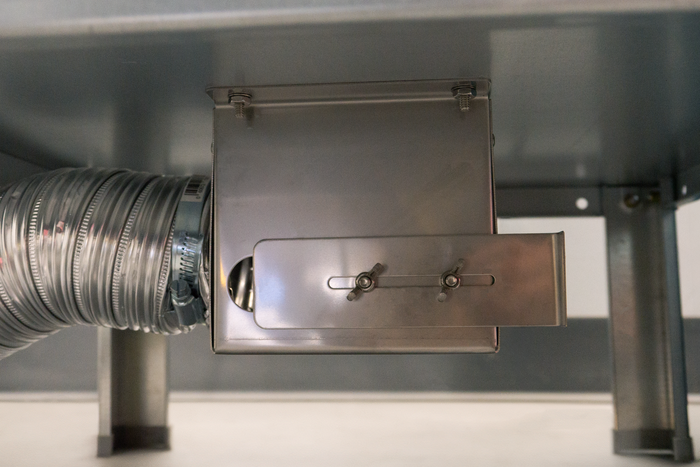
Step 4: Install the Blower System
- Install the blower system either by penetrating the outside wall or setting it in a window with proper support.
- Attach the provided 90-degree elbow to point downwards on the building's exterior to prevent rainwater from entering the duct.
- Note that the installation method varies if using the Multi-Mount bracket.
- Securely mount the system as the motor may vibrate over time, especially if dust accumulates in the blower.
- The motor assembly is pre-mounted onto the Wall mount bracket.

Step 5: Connect Flexible Duct
- Connect the blower system to the bypass/collection box using the flexible aluminum duct.
- Carefully extend the duct up to 8 feet and secure it at both ends to the blower housing and the bypass/collection box with the provided hose clamps.
- Note: It's advisable to attach the duct to the Bypass Collection Box before installing the kiln on the stand, as it can be challenging to maneuver under the kiln once in place.
- NOTE: A 15 foot flexible duct is available.

Step 6: Plug In Vent
- Plug the switched cord into a standard 120-volt receptacle. (NOTE: 220-240 volt models are available)
- If necessary, use a grounded extension cord due to the low amperage required.
- Ensure that you secure the cord away from any areas where it could cause tripping or come into contact with heat sources.

Multi-Mount Bracket
- The vent system includes a Multi-Mount bracket, allowing you to mount the vent on the floor or wall with the outlet pointing up.
- This is ideal for using existing wall penetrations that cannot support the vent on their own, such as windows, or for routing the vent through a roof or into a central vent system.
Room Air Replacement
- The Vent-Sure system moves up to 146 cubic feet of air per minute.
- We suggest opening a window slightly, or bringing another fresh air source into the room, to replace this room air.
Operation of the Kiln Vent System
- Plug the blower cord into a 120 Volt outlet (note: 220-240 volt models may vary).
- Close all kiln openings such as peepholes unless specific additional air venting is needed.
- Turn on the vent using the in-line switch on the power cord.
- Close the lid and fire. For heavy loads with lots of fumes you may want to avoid firing faster than 150°F per hour to prevent the generation of more fumes than the system can eliminate.
- Adjust the flow control on the Bypass Box to regulate exhaust flow: larger openings reduce exhaust fumes, while smaller openings increase them.
ADJUSTING THE BYPASS SYSTEM
- The sliding adjuster on the Bypass System fine-tunes the amount of venting for your kiln.
- Adjusting can be tricky as many factors affect the required "pull" of the vent system.
- Factors include the amount of fumes from your work, carbon content in clays, and the makeup of the clay/glaze.
- "Static pressure" in vent ducts also impacts venting needs, with bends and long duct runs increasing pressure.
- Begin adjustments with the valve half-open to gauge its effectiveness.


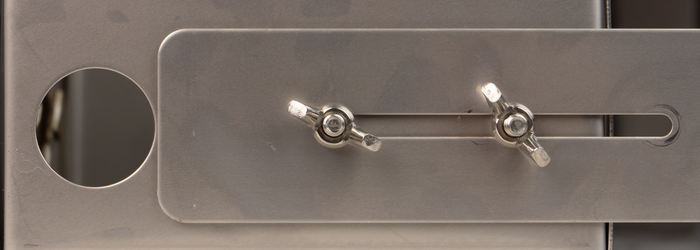
The Smoke Method for Checking Kiln Ventilation
- Turn on the vent with the kiln off and empty.
- Close the bypass valve fully for maximum suction.
- Light and then blow out a piece of paper to create smoke. Hold it near the lid's cracks.
- If smoke is pulled in, adjust the bypass valve open until the smoke stops being drawn in, then slightly close it to increase draw again.
- Test again at about 100°F.
- Perform a similar test at the kiln’s bottom hole to compare suction levels. Ensure the kiln is powered off to avoid electrocution risks.
For Gross Adjustment
Remember that the sliding adjuster is for fine adjustment. Drilling or plugging the holes in the floor (and possibly adding or plugging holes in the top) is how you would dramatically change the amount of air vented.
VENTING CODES
- OSHA has set standards for carbon monoxide exposure of 35 ppm (parts per million) for long-term exposure and 200 PPM for short-term exposure. Independent testing has shown that fumes near the kiln can exceed 200 PPM near the kiln during the firing of greenware. This can cause headaches, fatigue, sore throats and nausea. When properly installed and operated, a downdraft vent removes all harmful fumes and provides a safer working environment.
- Most states and localities have set venting requirements for firing kilns in public places. Your local and state health board should have this information.
- The Uniform Mechanical Code says that you must vent ceramic kilns. It says that you can use a canopy-type hood (and gives specific requirements for such use) or that “listed exhaust blowers may be used when marked as being suitable for the kiln and installed in accordance with manufacturer’s instructions.”
- The L&L Vent-Sure vent is listed to UL499 standards by MET for L&L Kilns and is appropriate to meet this ventilation requirement. L&L takes no responsibility for improperly installed vents or kilns nor do we take responsibility for the use of other vents with our kilns.
REGULAR MAINTENANCE
- Periodically inspect the aluminum duct for leaks and replace as needed.
- Check for corrosion, especially with clays high in sulfur, phosphorus, or fluorine.
- Clean any wax or carbon buildup if using wax resist techniques or high-carbon clays.
- Every two years, unmount the fan and clean the squirrel cage with compressed air, particularly if in a dusty environment or if mounted on the floor.
- For vertically mounted discharge ducts, use a water trap to prevent condensation from damaging the motor. Horizontal mounting avoids this issue. If the discharge duct of the vent is mounted pointing up you may get water that condenses in the duct drop down and rust out the motor. Taking it apart and spraying with WD-40 can restore the motor in some cases.
INSTALLATION OF MULTIPLE VENTS
For more information see: hotkilns.com/vent-doubler-system
VENT DOUBLER SYSTEM
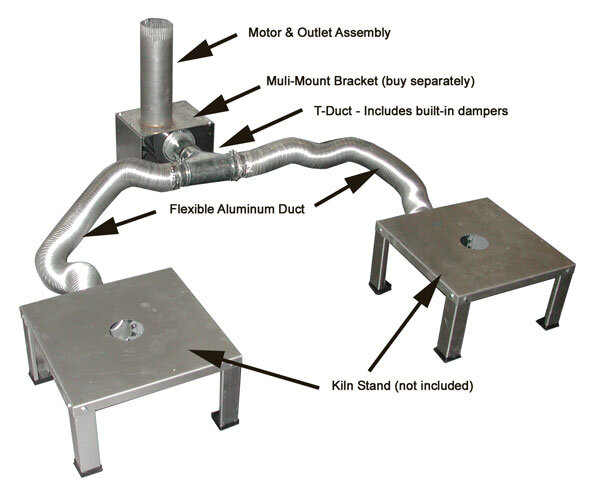
The Vent Doubler system includes:
- One extra Bypass Collection Box
- One extra Flexible Aluminum 8 foot Duct
- One “T” Connector with dampers.
You can vent two 10 cubic kilns with one Vent-Sure plus this Vent Doubler System.
CENTRAL VENT SYSTEMS
Multiple Vent-Sure systems may be installed individually, or each system may be connected to a central duct. The following information is provided to help the installer make decisions concerning the size and length of the central duct.
CENTRAL DUCT SIZING
|
Quantity of Vent Systems |
Diameter of Central Duct |
|---|---|
| 1 | 4" |
| 2 | 6" |
| 3 | 8" |
| 4 | 8" |
| 5 | 10" |
| 6 | 10" |
EXTENDING DUCT LENGTH
-
The duct may be 60 feet in length
- The duct may include up to four 90° bends, without a significant drop in static air flow or a reduction in kiln air pull.
- If you have a choice run two 45 deg bends rather than one 90 degree bend or use flexible duct which has a gentler bend).
- You may use any galvanized, stainless or aluminum duct.
- The outlet duct size (after the motor) is 4” diameter.
- The inlet duct (before the motor) is 3” diameter.
VENT CONTROL OPTION
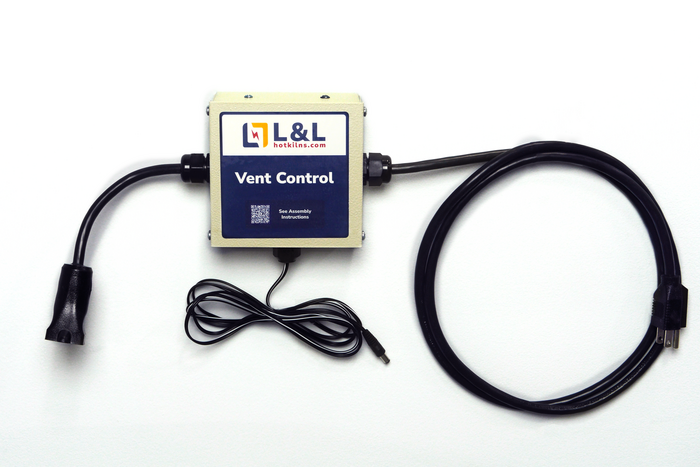
The Vent Control allows you to automatically control the operation of the Vent-Sure kiln vent with one of the outputs from the DynaTrol or Genesis controller.
See hotkilns.com/instruct/vent-control for vent-control instructions
FREQUENTLY ASKED QUESTIONS
How do I know if the system is working?
- See our comments under “Adjusting the Bypass Valve”
How hot does the duct get during the firing?
- Not very, for two reasons. One is that the Vent-Sure does not draw out much heat from the kiln.
- The hotter the kiln gets, the less hot air that is extracted by the vent motor.
- The other is that the bypass box combines fresh cool air with the hot air from the kiln before passing through the ductwork.
How long can the duct be and how many bends can it have?
- Up to 60 feet of ducting containing four 90 degree bends may be safely used with no drop in static air flow at the duct exhaust point or a reduction in draw at the kiln.
- The ducting can be run either horizontally or vertically.
- If you have a choice run two 45 deg bends rather than one 90 degree bend or use flexible duct which has a gentler bend).
Can I vent through a ceiling and/or roof?
- Yes. You will need use the multi-mounting bracket, so that you can position the motor output vertically. Additionally, you need to make sure that you install a water trap. At the bottom of the longest vertical run, install a u-shaped bend to catch any condensation that forms before it enters the motor. Of course if you are going through a roof, you will also need a rain cap and screen.
- You do not normally need double wall ducting when going through the roof since the pipe or duct does not reach high temperature. It is always advisable to check your local building codes for their requirements.
How do I determine the size, number, and location of holes in the top and bottom of the kiln?
- As a general rule, you should have one 1/4 inch hole for every 4 cubic feet of kiln volume.
- The holes are normally placed within a 4 inch circle in the center of the kiln floor.
- See our hole chart on this page.
- L&L does not normally recommend drilling holes in the top except for certain instances where airflow needs to be increased such as for glazes which need an oxygen rich environment.
Will the fumes coming through the vent damage my plants, the neighborhood pets or disturb the local environment?
- Fumes have been diluted enough already when they are exhausted, however that depends on how you have your bypass box setup.
- We do not recommend placing the outlet of the vent below an open window.
- Once the fumes are exhausted, they will quickly be diluted by the outside air, so it is only the immediate area around the vent that you need be concerned about.
Will using the vent cause my firing to take longer?
- Generally, the vent will only add a little time to your kiln firing.
- The vent system removes only a small amount of heat from the kiln due to the physics of how thin air gets at very high temperatures. (L&L NOTE: We have seen vents overpower smaller kilns - so it is important to adjust the amount of venting in some cases.
- On the other hand an example of an e23T 7 cubic foot kiln firing an 85 pound load on Fast Glaze program to cone 8 took 7 hours and 4 minutes with a vent on and 6 hours and 24 minutes without a vent. The vent was on the whole time).
What does it cost to operate the vent system?
- The vent system should likely cost less than 1 cent/hour to operate (electricity costs).
- Downdraft vents are still vastly more efficient than hoods which remove tons of air from the kiln room while the Vent-Sure only removes a small amount of air from the kiln.
- (It does cost more to run the vent because it does take heat out of the kiln. For example an e23T 7 cubic foot kiln firing an 85 pound load on Fast Glaze program to cone 8 took 70 KW hours with a vent on and 62 KW hours without a vent. At 8 cents per KW hour that would be a cost of $0.64 more for the firing. The vent was on the whole time).
Will the cold air entering the kiln damage the product?
- No. The amount of air coming in is too small unless you drill holes in the lid, which is not normally recommended.
- The air coming in is also distributed throughout the kiln evenly.
Will faster cooling crack the ware if I leave the vent on during the cooling Cycle?
- No. Most kilns will cool faster with the vent system, but it is achieved at such an even rate and distribution that there would not be any damage to ware.
- (L&L NOTE: The vent will remove more molecules of air and hence heat as the kiln cools. This is because the density of the air increases the lower in temperature you go. This is one reason why kiln vents are so efficient - they don’t remove too much heat when you don’t want them too at the higher temperatures).
What should I do if I still smell fumes?
- Check all ductwork for leaks and see our comments on “Adjusting the Bypass System”.
If using a hood type vent (like the Vent-a-Kiln) do you need a kiln vent (like the Vent-Sure) also?
- You need to vent fumes from the kiln and the room and heat from the room. You must have ambient ventilation in a small room for heat and to remove fumes that may not be fully removed by the kiln vent. If you have a very large room that can dissipate heat and trace fumes than you may not need ambient ventilation.
- The Vent-Sure is designed to remove fumes that are generated in the kiln from the kiln and therefore from the room. The Vent-Sure downdraft kiln vent does not remove enough heat from a small room to be used for ambient ventilation.
- If you have a good overhead vent hood you may discharge the output of the Vent-Sure into that hood.
At what temperature should you turn off the Vent-Sure kiln vent?
A customer writes: When firing glazes what is a good temp to turn off the vent so kiln can hit target temp in my case 2190 Deg F. Do glazes off-gas after say 2000 degrees? Is there a general temperature to turn off vent?
Generally speaking it is best for your kiln to leave the Vent-Sure on for the entire time the kiln is heating up. Mostly this is to get all of the corrosive fumes before they get to your elements, wiring, and other metal parts of the kiln. You can leave it on for the cooling as well if you need it to cool off more quickly. Usually a slower cool-down is preferred though, so often the fan is turned off for the cool-down. High-fire clays and glazes out-gas until the kiln begins to cool. Once the glaze has set, and the clay has vitrified no more gasses escape. The heat in a red-hot kiln is almost all radiant heat. The hotter the kiln gets, the fewer and fewer air molecules are even present inside. Because of this- it is only helping the heating rate a tiny little bit to turn off the vent before the end of the firing.
How long does a Vent-Sure downdraft vent last?
The Vent-Sure downdraft kiln vent is pulling not only air but moisture and the products of hot moisture and the chemicals that are present in the clay. Some of these products are highly acidic (like sulfuric acid, hydrofluoric acid and others). The exact amount and composition of the effluents of your kiln, and hence in the vent, will vary with how dry your work is and what is in the clay to begin with. The Vent life seems to be totally dependent on these conditions. The more moisture and acids created by the materials in the clay and water then the shorter the vent life. If you have good conditions the vent can last for many years - if not - then you will be replacing various parts over the years. That said - L&L’s experience has been very positive. We have sold thousands of Vent-Sures. We sell very few replacement motors and other parts. The most vulnerable part seems to be the thin aluminum flexible duct that goes from the kiln to the vent motor. This is cheap and you can find replacements locally. The motors hold up very well in terms of lubrication and vibration. The Vent-Sure is warranted for three years.
FEATURES AND SPECIFICATIONS
ADJUSTABLE AMOUNT OF VENTING
- A sliding adjuster on the vent Bypass Collection Box adjusts the amount of venting from the system.
- Vent only what you need to vent - don’t waste heat and energy by venting more than you need.
EXTERNAL VENTING
- External venting is safer and surer than venting to the inside of your kiln room with a filter.
REMOTE MOUNTING OF MOTOR
The vent blower motor is mounted to a wall plate with a 12” length of exhaust pipe that mounts on the wall (see photo). This keeps the heat of the kiln away from the motor (for longer motor life) and keeps the motor vibration away from the kiln. (With the special “Multi-Mounting Bracket” the vent motor may be mounted on the floor or a wall with the outlet pointing up and then connected to an existing vent system or 4” wall outlet. If you decide to mount it this way see the caution on page 5).
MOUNTS ON ANY L&L KILN
The Vent-Sure vent system can be installed on almost any kiln. It requires only that you drill several small vent holes through the kiln floor (note that if mounting the bypass/ collection box to the stand, that four studs are factory installed on the bottom of the stand). Mounting hardware is included. Note: L&L Vent-Sure vent are not c-MET-us listed for use on any kiln except those made by L&L Kiln Mfg., Inc.
POWERFUL VENT MOTOR
The blower vents up to 146 CFM (cubic feet per minute at 0 static pressure and 110 CFM at 0.500-In. static Pressure). Remember - not all of this air comes from the kiln - some comes from the Bypass Collection Box.
OUTLET TEMPERATURE UNDER 150ºF
The outlet temperature of the air is less than 150º F as long as you do not exceed the recommended holes in the kiln.
FLEXIBLE DUCT INCLUDED
8 feet of flexible expandable aluminum 3” diameter duct is included along with necessary hose clamps.
Longer lengths or lengths of 3” stove pipe can be used as well.
LOW ELECTRICITY USAGE
The Vent-Sure vent System uses only 0.75 amps at 120 volts.
VENTS UP TO 20 CUBIC FEET OR MORE
The Vent-Sure vent System was designed to be used with all L&L model kilns. We recommend one vent system for kilns up to approximately 20 cubic feet. On larger kilns, depending on how much venting you need, you may need more than one vent system. (This really depends on how much venting you need for your situation). Note that you can always add another vent if you find you need more venting.
120 VOLT MOTOR SPECIFICATIONS
- 120 VOLT MOTOR PSC Blower, Type: Forward Curve, Direct Drive
- Wheel Dia. (In.):3-15/16,Wheel Width (In.):2-1/2
- CFM @ 0.000-In. SP:146, CFM @ 0.100-In. SP:140, CFM @ 0.200-In. SP:126, CFM @ 0.300-In. SP:124. CFM @ 0.400-In. SP:120, CFM @ 0.500-In. SP:110
- Voltage:115, Hz:50/60, Phase:1, Full Load Amps:0.75, RPM:3100
- Bearing Type: Ball, Motor Type: Permanent Split Capacitor, Motor Enclosure: Open, Motor Insulation: Class B, Thermal Protection: Auto
- Lead Length (In.):13, Conduit Box: Yes
- Ambient Temp. (Deg. F):104, Max. Inlet Temp. (Deg. F):104
- Inlet Dia. (In.):3-1/8, Outlet Height (In.):2-3/16, Outlet Width (In.):3-1/4, Overall Height (In.):5-3/4, Overall Width (In.):6-5/16, Overall Depth (In.):5-3/8, Mounting: All Position, Housing Finish: Gray Enamel, Housing Material: Rolled Steel
- Agency Compliance: UL Recognized US and Canada (E47479)
220-240 VOLT MOTOR SPECIFICATIONS
- Item-PSC Blower, Type-Forward Curve, Direct Drive
- Wheel Dia. (In.):3-3/4, Wheel Width (In.):1-7/8
- CFM @ 0.000-In. SP:133,CFM @ 0.100-In. SP:128, CFM @ 0.200-In. SP:126, CFM @ 0.300-In. SP:119, CFM @ 0.400-In. SP:112, CFM @ 0.500-In. SP:105
- Voltage:230, Hz:50/60, Phase:1
- Full Load Amps:0.33, RPM:2880
- Bearing Type: Ball, Motor Type: Permanent Split Capacitor, Motor Enclosure: Open, Motor Insulation: Class B, Thermal Protection: Auto, Lead Length (In.):13, Conduit Box: Yes, Ambient Temp. (Deg. F):104, Max. Inlet Temp. (Deg. F):104
- Inlet Dia. (In.):3-1/4, Outlet Height (In.):2-1/2, Outlet Width (In.)2-9/16, Overall Height (In.)6-9/16, Overall Width (In.):5- 5/8, Overall Depth (In.):6-9/16
- Mounting: All Position, Housing Finish: Gray Enamel, Housing Material: Rolled Steel T
- he Vent-Sure vent is c-MET-us listed in both the US and Canada for use with L&L listed kilns. UL 499, CSA C22.2, No. 122, CSA C22. Listing No E112742.
PARTS


